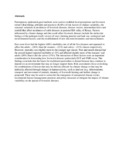The impact of climate change on the incidence of cattle diseases in a pastoral area of Kenya

Date
2013Author
Moenga, B O
Muchemi, G M
Kang’ethe, E K
Kimenju, J W
Mutiga, E R
Matete, G O
Language
enMetadata
Show full item recordAbstract
Participatory epidemiological methods were used to establish local perceptions and livestock owner’s knowledge, attitudes and practices (KAPs) of risk factors of climate variability, the seasonal variations in incidences of livestock diseases, disease vectors, intermediate hosts and rainfall that affect incidences of cattle diseases in pastoral Rift valley of Kenya. Factors influenced by climate change and that could affect livestock diseases include the molecular biology of the pathogen itself; vectors (if any); farming practice and land use; zoological and environmental factors; and the establishment of new microenvironments and microclimates.
East coast fever had the highest (68%) morbidity rate of all the five diseases and appeared to affect the adults - (26%) than the weaners - (21%) and calves - (21%) classes respectively. However, mortality was slightly more in the younger age classes. Foot and mouth disease had the second highest reported morbidity at 52% and affected slightly more of the weaners’ and adults (20%) than it did the calves (15%). The interaction of these factors were an important consideration in forecasting how livestock diseases particularly ECF and FMD occur. The findings conclude that the future for traditional pastoralists is dismal because they continue to depend on an environment that may no longer support them. Risk assessments focus on looking for combinations of factors that may be directly affected by climate change or that may be indirectly affected through changes in human activity, such as land use (e.g. deforestation), transport and movement of animals, intensity of livestock farming and habitat change is proposed. These may be used to screen for the emergence of unexpected disease events, recommend disease management practices and policy measures to mitigate the impact of climate variability on the spread of livestock diseases.
Citation
Moenga B O, Muchemi G M, Kang’ethe E K, Kimenju J W, Mutiga E R and Matete G O 2013: The impact of climate change on the incidence of cattle diseases in a pastoral area of Kenya. Livestock Research for Rural Development. Volume 25, Article #67. Retrieved July 18, 2014, from http://www.lrrd.org/lrrd25/4/moen25067.htmSponsorhip
Participatory epidemiological methods were used to establish local perceptions and livestock owner’s knowledge, attitudes and practices (KAPs) of risk factors of climate variability, the seasonal variations in incidences of livestock diseases, disease vectors, intermediate hosts and rainfall that affect incidences of cattle diseases in pastoral Rift valley of Kenya. Factors influenced by climate change and that could affect livestock diseases include the molecular biology of the pathogen itself; vectors (if any); farming practice and land use; zoological and environmental factors; and the establishment of new microenvironments and microclimates. East coast fever had the highest (68%) morbidity rate of all the five diseases and appeared to affect the adults - (26%) than the weaners - (21%) and calves - (21%) classes respectively. However, mortality was slightly more in the younger age classes. Foot and mouth disease had the second highest reported morbidity at 52% and affected slightly more of the weaners’ and adults (20%) than it did the calves (15%). The interaction of these factors were an important consideration in forecasting how livestock diseases particularly ECF and FMD occur. The findings conclude that the future for traditional pastoralists is dismal because they continue to depend on an environment that may no longer support them. Risk assessments focus on looking for combinations of factors that may be directly affected by climate change or that may be indirectly affected through changes in human activity, such as land use (e.g. deforestation), transport and movement of animals, intensity of livestock farming and habitat change is proposed. These may be used to screen for the emergence of unexpected disease events, recommend disease management practices and policy measures to mitigate the impact of climate variability on the spread of livestock diseases.Publisher
University of Nairobi
Collections
- Faculty of Agriculture [225]
